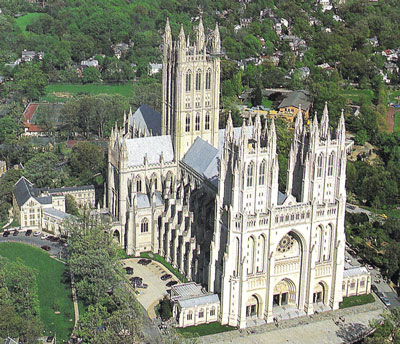Bach's St. John Passion at National Cathedral
This review is an Ionarts exclusive.
Sunday afternoon, the Washington National Cathedral Choir and Baroque Orchestra presented Bach’s St. John Passion, conducted by Cathedral Director of Music Michael McCarthy. McCarthy’s unhurried approach to the opening chorus allowed its full intensity to show forth, while enhancing textual clarity in the labyrinth of runs. The deep orchestral crescendo before the choir’s first entrance astutely framed the tripartite repetition of the word “Herr,” recalling the trinity. Sighing two-note slurs on the words “allen Landen” pointed toward the pain found in the earthly setting of the passion narrative.
Washington National Cathedral
As narrator, tenor Ole Hass (The Evangelist), carrying the bulk of the work’s recitatives, communicated the often extended text with soaring tone and native diction. Bass James Shaffran (Christ) captured the depth of Jesus’s sparing, yet profound words. Soprano Elizabeth Weigle’s bounding performance of the aria Ich folge dir (“I follow Thee”) featured a highly resonant and capable instrument; however, Weigle, at times behind, did not quite coordinate seamlessly with the Baroque flute and excellent continuo. She showed impressive control on the long notes of the tearful aria after Jesus’s death, Zerfließe, mein Herze (“Melt, my heart”), where Bach showed a new musical reality in the words Dein Jesus ist tot (“Thy Jesus is Dead!”) by composing a distant modulation that she handled well. Nevertheless, Weigle’s immense vocal attributes were limited by her further lack of rapport with orchestra and conductor. Magdelena Kožená’s cantatas with John Eliot Gardiner perhaps set the bar in terms of rapport. Aaron Sheehan (tenor), Roger Isaacs (countertenor), and Bobb Robinson (baritone) were equally strong.
The Washington National Cathedral Choir, comprising about 35 singers, mixes professional tenors and basses with and boy and girl choristers from the Cathedral’s choirs. Singing with belief and comprehension of text, the choir appeared closely attuned to McCarthy’s direction. McCarthy’s unique experience as a vocalist (with the Gabrieli Consort and Monteverdi Choir) allowed him to use simulated vocal technique to help the sopranos place the highest note in the chaotically aggressive Kreuzige, kreuzige! (“Crucify Him!”) section.
The only other conductor I have experienced (live) so connected to his singers is John Eliot Gardiner (yes, more so than Maasaki Suzuki), whom McCarthy has worked with substantially. Notwithstanding hints of fatigue (read: intonation issues), the final chorus, Ruht wohl (“Rest in peace”), created a bittersweet mood one never wanted to end, embodying the weariness at the close of the draining emotional journey through the Passion narrative. A glimpse of the destiny of heaven is foreshadowed in the words Macht mir den Himmel auf und schliesst die Hölle zu (“Openeth the heavens up to me and closeth hell”), when Bach allows light to briefly shine into the music.
CORRECTION:
The original text of this review implied that only girl choristers sang in this performance. According to concerned readers, there were boy trebles performing in the choir, too, whose contributions we did not mean to overlook.





















































1 comment:
Thank you for that lovely review. On wednesday evening of Holy Week, the Cathedral Choir of Girls and Men performed Scarlatti's Stabet Mater, under Mike McCarthy's direction. It was a repeat of a National Gallery performance the week prior. At the wednesday performance, the strong communication between choirmaster and the singers which you reference in the Passion, was even more in evidence. It was a truly extraordinary performance..
Post a Comment